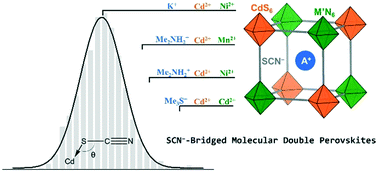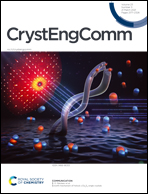Structural insights into a new family of three-dimensional thiocyanate-bridged molecular double perovskites†
Abstract
Extending new families of ABX3-type three-dimensional (3D) molecular perovskites based on diverse X-site molecular ligands is of interest in designing advanced hybrid materials for wide usage. Being a pseudo-halogen ligand, the thiocyanate anion is expected as an X-site bridge to construct 3D molecular perovskites, but has only yielded two pure inorganic instances so far. Herein, we report four new 3D SCN−-bridged molecular double perovskites with a general formula of A2[CdM′(SCN)6] (A/M′ = K+/Ni2+, Me2NH2+/Ni2+, Me2NH2+/Mn2+, Me3S+/Cd2+), including three unprecedented hybrid instances incorporating organic cations. A detailed comparison between these SCN−-bridged molecular perovskites and some azido-bridged analogues, on their host–guest interactions and structural distortions, revealed that the bent Cd–S–C angles in these SCN−-bridged molecular perovskites vary in a narrow range, endowing their frameworks with a high structural distortion and a relatively strong structural rigidity. The present study not only extends SCN−-bridged 3D molecular perovskites to enrich the perovskite family, but also paves a way for the rational design of new molecular perovskites.

- This article is part of the themed collection: Coordination Networks


 Please wait while we load your content...
Please wait while we load your content...